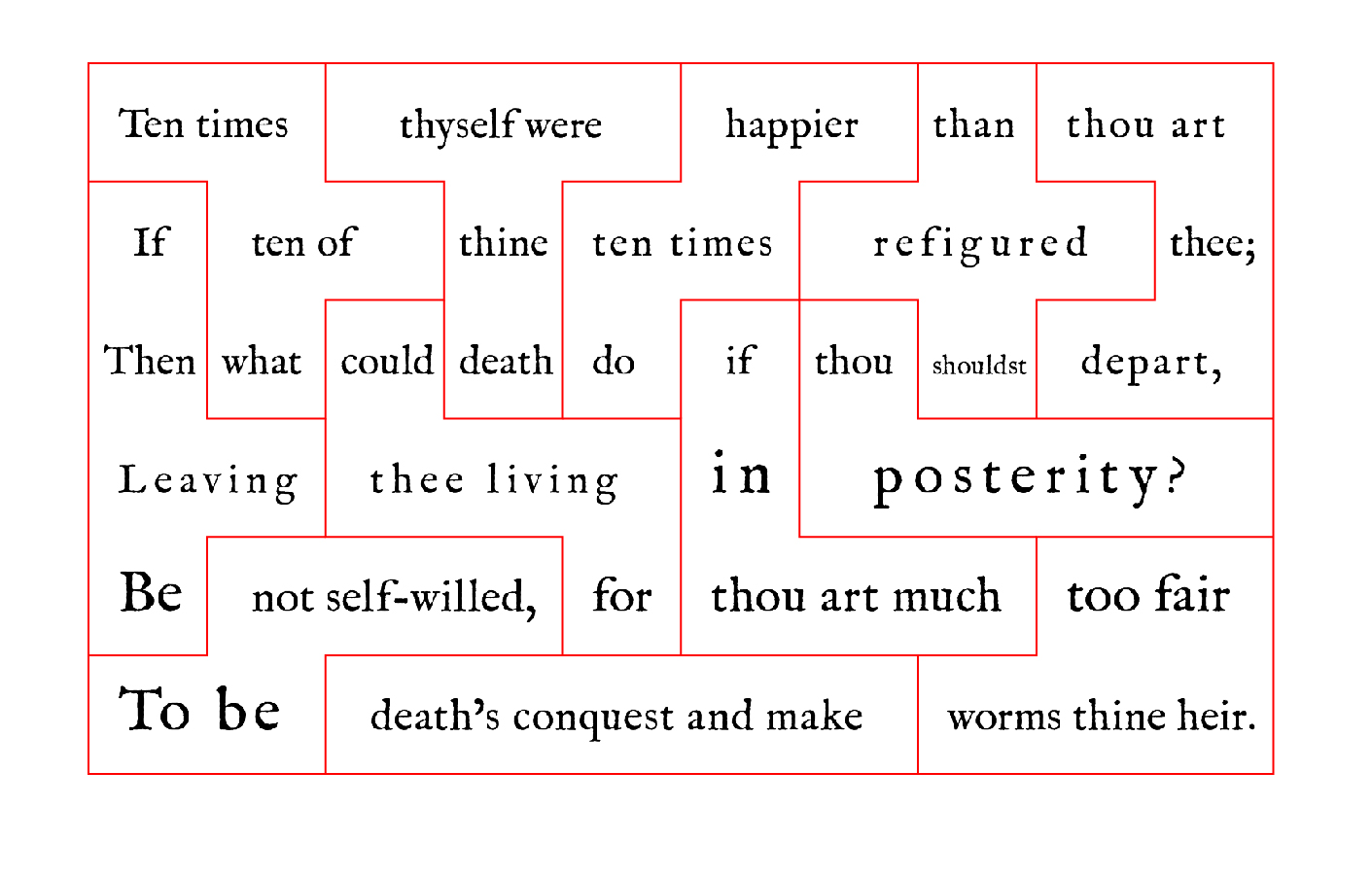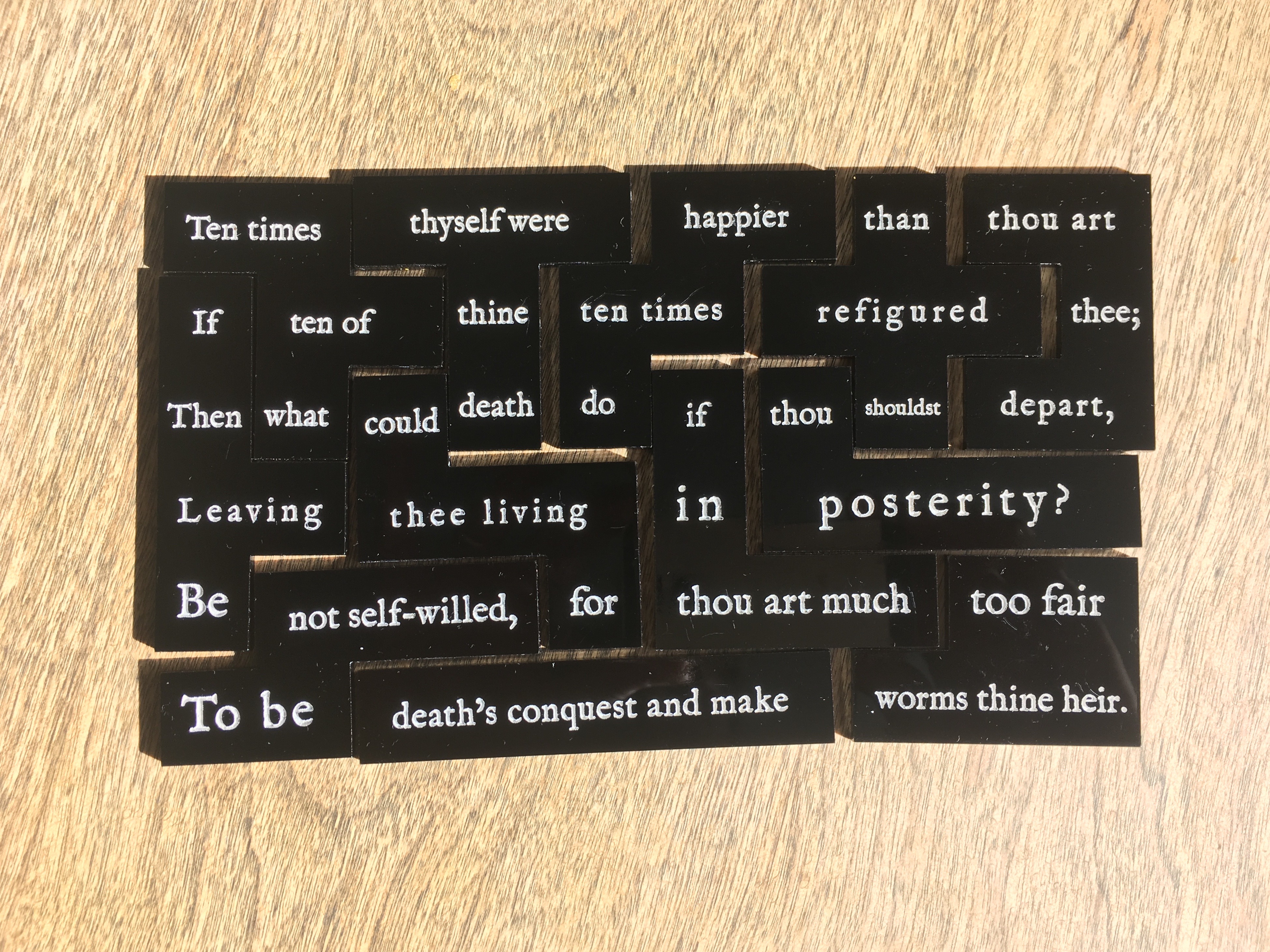
To make a poem into a puzzle we treat words as sequences of syllables and map them to a grid, typically transcribing them on graph paper. The syllables of a sonnet comprise 14 lines of pentameter, which may be distributed across a 14x10 grid, with each syllable in the poem assigned to one of 140 positions. The poem is thus visualized as a matrix of syllable-squares, in which syllables (a basic prosodic unit) are placed in contiguous cells (a basic geometric unit). Every printed word is a horizontal span of a certain length corresponding to the number of letters required to spell the word, but for our purposes word-length is determined solely by the number of syllables, independent of orthography (the single-syllable word “screeched” has the same unit-value as “it”).
On graph paper, a poem may then be rendered in a kind of shorthand as a configuration of dots and dashes, where each dot represents a syllable and syllables belonging to the same word are connected with hyphens. Following I. A. Richards, we describe these dot-dash models as “purified dummies,” reductive transcriptions that stand between the verbal and the geometrical aspects of the poem and guide the transformation of a structure of words into an arrangement of shapes.

With the poem so schematized, we are in a position to cut the poem into puzzle pieces. Most of the puzzles we’ve been making follow two rules: (1) put five syllables or dots on each puzzle piece, (2) keep multisyllabic words intact, which is to say, don’t divide a dash. These rules will decompose a poem into “pentominos,” the polygon in a plane made of five equal-sized squares connected edge to edge. There are twelve pentominos, twelve ways of configuring five squares as a freestanding shape but then myriad ways of packing pentominos into a frame. Thousands of solutions have been found to canonical packing puzzles. For example, there are 16,146 ways to tile a chess board (an 8x8 frame) with 12 pentominos and a square tetromino.
This geometry is indifferent to the linear integrity of verse. Where one normally reads the first line of a poem before reading the second, puzzle shapes can introduce a competing order of reading. We use pentominos to collect words from different lines and impose them onto a single piece thereby manifesting the occult structure figured by the dots and dashes of the purified dummy. Even the rectangular 1x5 pentomino piece—which can hold one five-syllable word, five one-syllable words, or any grouping of words in between—carries off half a line of pentameter when fit horizontally into a sonnet. Change the orientation of this piece, turning it 90º, and it will select five vertically contiguous words from five successive lines. Each unique pentomino shape departs in its own way from the left-to-right reading of verses, grabbing words from two, three, or four different lines.
In our earliest investigations, we focused on sestets (the last six lines of a sonnet) and added a third rule to the first two: (3) In converting a sestet’s 6x10 grid of syllable-squares into pentominos, use each of the 12 pentomino pieces only once. Successfully following all three rules results in what we’ve come to call the “piecification” of a poem, the reconciling of linguistic and geometric structures in a puzzle design. This design process activates two senses of the word solution: one is geometric and concerns the arrangement of pentominos alone, the other involves the effective correlating of shape and word, partitioning the dot-dash dummy in such a way that each of the twelve pentominos is assigned its proper share of syllables. In the case of the sestet, we know that there are 2,339 solutions for packing a 6x10 rectangular puzzle with pentominos (as shown by prior brute-force computational analysis). And yet we found it very difficult, when working by hand, to impose even one of these mathematically generated solutions on a given dot-dash model of a poem. We were able to expedite the piecification of the sestets by employing scripts in the programming language R, matching a sestet to geometric configurations computationally (in the second sense of “solving” mentioned above, we call these sonnets “sestet-solvable”). Although most sestets don’t match any pentomino arrangements, or “solutions” in the first sense, we’ve found that those sestets that do piecify often match only one. For example, we have discovered that Shakespeare’s 6th, 12th, and 15th sonnets are sestet-solvable, each having only one “solution” in the second sense. However, the other fourteen sonnets that belong to the so-called “procreation” sequence do not match any configuration of the 2,339 possible sestet-solutions that observe the third rule. A few sestets are promiscuously solvable: Elizabeth Barrett Browning’s famous 43rd sonnet in the Sonnets from Portuguese contains the most mutable sestet we have encountered thus far, matching 325 solutions.
In Adobe Illustrator we’ve created a template file that reproduces our original graph-paper grid and enables the efficient limning of pentomino edges. The graphic design application provides a grid to which we can easily snap line segments with the click of a button. With a solution in hand, which the script identified as the poem’s match, we quickly dissect an empty rectangular frame into pentominos and then fill these outlined shapes with the words that have been assigned to them. The digital medium furnishes us with a readily manipulable artifact. We typically place edges on one layer and words on another, separating geometric and linguistic design elements. The geometric layer contains paths, which the laser cutter will recognize as vectors to be scored into the material. The linguistic layer contains a bitmap of words which the laser cutter will engrave pixel by pixel as if it were an inkjet printer, only instead applying ink to paper, the laser removes material by pulsing. This last stage before fabrication requires us to make decisions about the poem as it will be printed on the puzzle pieces, including decisions about font-face and size, the accidentals of hyphenation, capitalization, and relative word positioning, all of which determine the scale and dimensions of the final product.

The Illustrator file is sent to a laser cutter in the same way a file is sent to laser printer. The machines we have been using are of the “flying optic” variety which means that the bed is stationary and the laser mounted above moves along x-y axes. Because the laser cutter can’t recognize the layers created in Illustrator, we have to represent the separation of geometric and linguistic elements by means of a color scheme: red for vector cuts and black for raster engraving. We draw the hairline vectors in red (.01 pixels in width) and color the text black.
This dual color scheme determines the motion of the laser cutter by associating each layer with either line-by-line raster engraving or vector-path scoring. In the first case, as it etches letter forms, proceeding left to right and top to bottom as would an inkjet printer, and in the second, cutting through to create the edges of the pieces, ranging across the surface of the material, exposing portions of the original grid on which the poem was imposed. We have worked with a variety of materials: cardboard, plywood, birch, Masonite, bamboo, and acrylic. Each material requires us to specify different settings for the laser (power, speed, and pulses per inch).
Cardboard is quickly cut with the laser at lower settings, while hardwood is only pierced at a higher intensity. In many cases we make multiple passes with the laser at higher speed or lower power to avoid scorching the puzzle surface or setting the material on fire. A slow moving, high-powered beam can discolor wooden surfaces; although this can result in an aesthetically pleasing effect. It’s good practice to tape down the blank board or sheet to the bed of the laser cutter to establish a proper registration for the text. We etch the words first because the hotter cutting passes can warp the material, making it harder to align the words on the cut pieces. After the puzzle has been etched and cut into pieces, we lift it off the bed of the cutter, wipe it down (sometimes filling the engraved letter forms with a contrasting paint), and hand it over to the nearest puzzle enthusiast.
